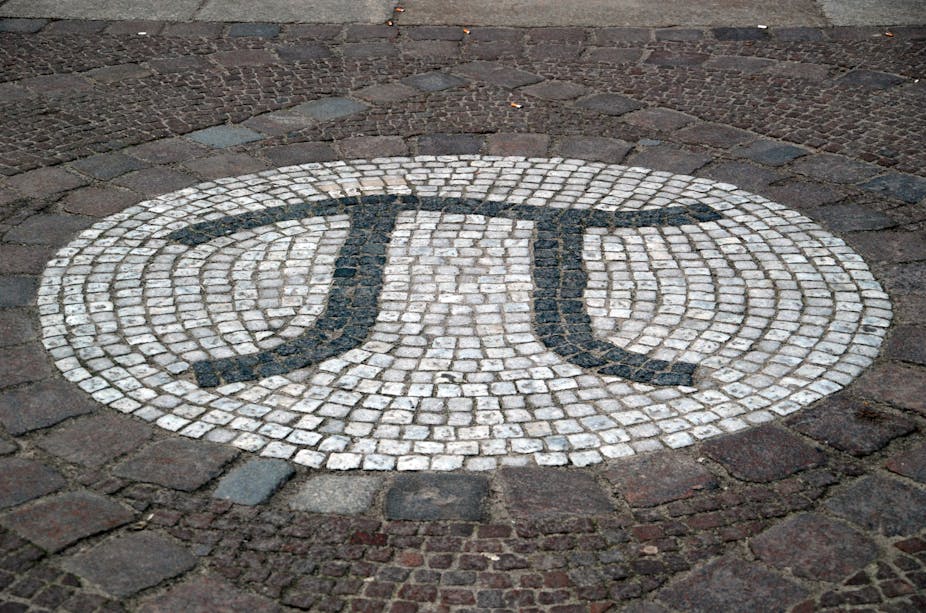Most people have heard of the mathematical constant Pi (π), and will know that it’s roughly 3.14. Taking inspiration from these three digits, March 14 (3/14 in the US date format) is heralded as international Pi Day, first marked by US physicist Larry Shaw in 1988.
This year brings a unique opportunity to demonstrate an entirely unnecessary degree of zeal by marking Pi Day correct to nine decimal places on March 14, 2015, at 9.26am 53sec – corresponding to 3.141592653, the first 10 digits of Pi. If you’re too busy this weekend, you could book in July 22 – another way of expressing Pi approximately is the fraction 22/7.

Pi is calculated as the ratio between a circle’s circumference to its diameter.
Pi is always the same value, no matter the size of the circle, which makes it an important mathematical constant.
The ancient Babylonians calculated Pi as three by taking three times the square of the circle’s radius, later refining the value to 3.125. Archimedes of Syracuse (287-212 BCE) approximated Pi by inscribing polygons on the inside and outside of a circle. By increasing the number of sides of the polygons, Pi could be calculated to higher levels of accuracy.
Even today, calculating Pi to ever increasing levels of accuracy continues – it has now been found to an accuracy of over 13 trillion digits. There’s no reason to suspect this record will remain forever, even though only about 39 decimal places are sufficient for astronomical precision. There is no reason to be more precise for practical purposes but it is good scientific sport of sorts to strive to be ever more accurate.

Some Properties of Pi
Pi is an irrational number, which means it cannot be accurately represented as a fraction, a/b, where a and b are integers. An approximation is to express it as 22/7 (3.1428…) which is inaccurate by 0.04025%. A closer approximation is 104348/33215, which has a far smaller error of 0.00000001056% but is still, technically, wrong.
Pi is also a transcendental number which, simplified, are numbers that cannot be reduced algebraically (more accurately a number that is not the root of any non-zero polynomial equation with rational coefficients).
The proof that Pi is transcendental was found in 1882, but it had been known for much longer that if Pi was transcendental then it would be impossible to square the circle – to construct a square with the same area as a circle.
Putting Pi to use
Among the unusual uses for Pi is its relation to the nature of meandering rivers. A river’s path is described by its sinuosity, it’s tendency to wind from side to side as it traverses a plain. This is described mathematically as the length of its winding path divided by the length of the river as the crow flies. The average river has a sinuosity of about 3.14.
Albert Einstein actually made some observations about why rivers meandered as they did. He noticed that the water that flows faster around the outside of a bend, eroding that bank more quickly. This creates a larger bend. These bends eventually meet and the river forms a short cut through them. Hans-Henrik Stolum used these observations and noted a relationship with chaos theory, which suggests that, despite rivers straightening out as the rivers cut through the short cuts, the sinuosity tends to move back towards Pi.
Further examples of where Pi appears in the real world can be seen in a BBC item written for Pi Day 2008, and this New Scientist item written for the 2010 Pi Day. For example, Pi can be found in the measurements of the Great Pyramid of Giza, the angular distances of stars in the sky and in a song by Kate Bush. Included in the lyrics were the first hundred digits, or so, of Pi, but she went slightly wrong at around digit 50.
How to celebrate Pi day?
If you fancy some Pi-related entertainment for Saturday, you could try:
- Looking up whether your birth date appears in the decimal places of Pi – mine does, starting at 200,703, although if you want to know my age you’ll have to look it up.

Memorising the first digits of Pi. Piphilology, a system of mnemonics to help you remember the digits, may help. There are even piems (Pi poems) to help you remember. You may not beat the record-holder, which currently stands at 67,000 places.
Examining the first million digits of Pi – you might see a pattern no one else has.
Looking for Pi in everyday life. For example, it has featured in Mythbusters.
Follow #piday2015 on Twitter, and see how others have marked the day in the past.
… and finally
Albert Einstein, one of the greatest scientists the world has known, spent some time working on Pi as it related to rivers. Is it a coincidence that Albert Einstein was born on March 14, 1879? As he would have said himself, God doesn’t play dice.

